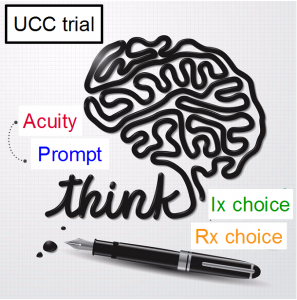Writing up – An excellent chance to think
 I’ve been writing up a detailed report on every facet of our Urgent Care Centre trial for Health Education England who kindly provided some very welcome financial assistance. The benefit of this process is that it is a good point to step back and think about what the results are telling us.
I’ve been writing up a detailed report on every facet of our Urgent Care Centre trial for Health Education England who kindly provided some very welcome financial assistance. The benefit of this process is that it is a good point to step back and think about what the results are telling us.
In May I wrote about the GP streaming process. In order to evaluate how successful GPs had been, an ED consultant reviewed all 904 patients giving us a ‘gold standard’ streaming outcome.
This ‘gold standard stream’ gave use a measure of the clinical need for each patient and an excellent tool against which to test PlacED™, the SortED disposition prompting system.
The prototype of PlacED we tested in May-June last year, used two pre-existing component outputs (acuity score and the ED disposition prompt). The ED prompt is stratified by acuity level and specific for each presentation. That specificity allows for specialised dispositions (eye casualty, sexual health clinic, psychiatric liaison team etc.) to be deployed, as well as locations within the ED (resuscitation, majors, minors etc.), or adjacent locations like UCC and Ambulatory Emergency Care (AEC). Encouraging use of those last two in SortED is key to reducing overcrowding in ED.
A simple test (comparing the consultant’s acuity score with their own gold-standard stream), shows that acuity alone is not sufficient to direct streaming. Acuity=1 or 2 patients were clear-cut requiring transfer to ED or direct referral. However, for Acuity=3 patients’ ideal streaming included: Send to ED, Send to AEC, UCC GP, UCC nurse and direct referral. The only outcome not suitable was ‘See & Treat’.
The food for thought was that not only did these two SortED system outputs relate to the gold-standard surrogate for clinicial need, but the nurses’ inputs did too. During the simulated clinical use of SortED, the nurses select investigations (Ix) then treatments and procedures (Rx) in the ‘Sort’ process. We know from our ED trial that these Ix selections have ‘predictive validity’ (see October 2017 blogs) agreeing with Ix actually given by ED clinicians.
With investigations (Ix) choice, there was a clear relationship between the number of investigations ‘requested’ and the consultant’s streaming decision. This was particularly good at identifying patients who needed AEC (a site with more investigative capabilities than UCC) or ED transfer. Dissecting investigations by type (examining observed versus expected rates), also showed characteristic patterns with the main streaming outcomes. ECG requests, for example, gave a promising discriminatory power for ED and AEC streaming.
With treatments and procedures (Rx) the types of Rx selected were very different for all the five streaming outcomes. Some Rx were predictors of the need for ED and AEC transfer, different Rx were associated with See an Treat or UCC nurse streaming.
Conclusions – Our first attempt at a UCC streaming tool did show stratification of patients related to their clinical need. However, it needs more discriminatory power particularly for Acuity 3 patients. Methods to identify patients suitable for AEC (a facility under-used by UCC GPs) are feasible. We also had no prompt for ‘See & Treat’, another category neglected by streamer GPs.
Improved streaming in Urgent Care Centres is both necessary and feasible. Nurses with the support of a suitably adapted SortED tablet will, in our view, be capable of this role.
Gillie Francis – Jul 2018


